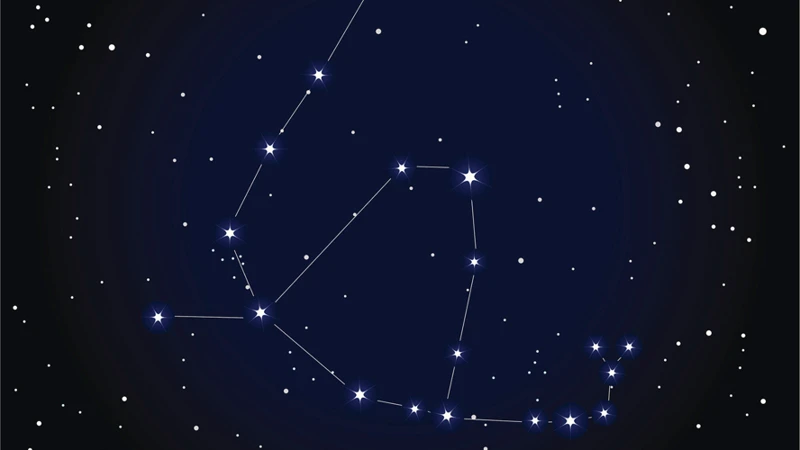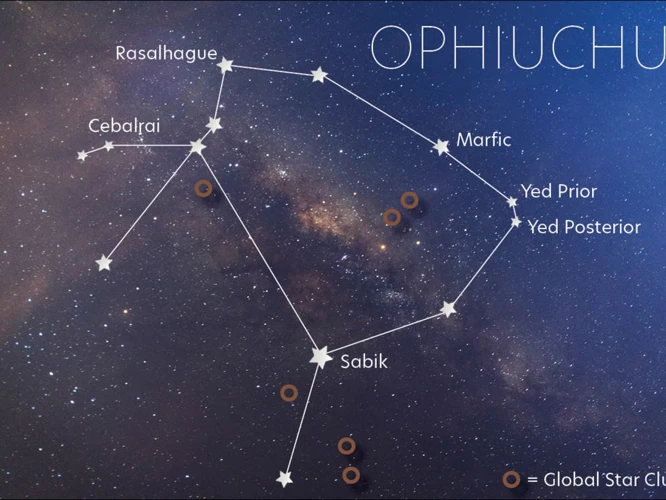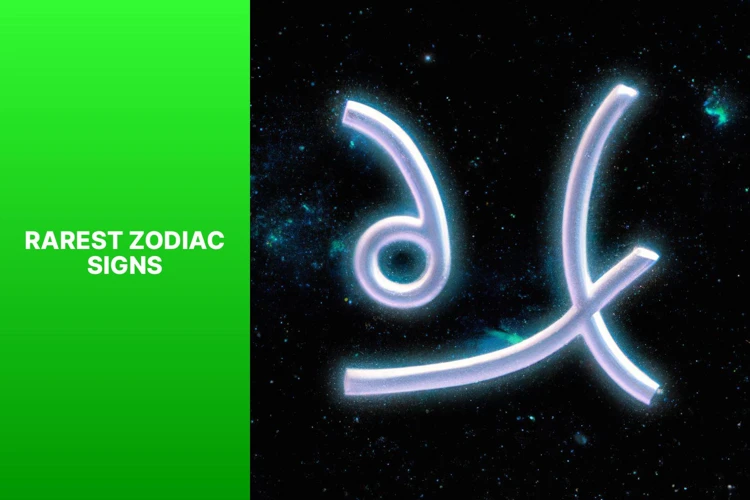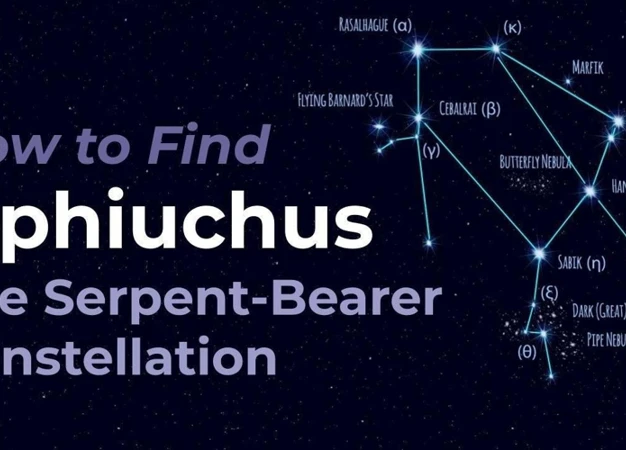Are you curious about Ophiuchus, the enigmatic 13th sign of the zodiac that has sparked controversy and confusion? In this article, we aim to unravel the mysteries surrounding Ophiuchus and debunk common misconceptions. From exploring its ancient origins to understanding its impact on astrological readings and personality traits, we’ll delve into the truth behind Ophiuchus. So, fasten your seatbelts and get ready to embark on a journey that will change the way you perceive the zodiac.
Myth: Ophiuchus is a New Astrological Discovery

Contrary to popular belief, Ophiuchus is not a new astrological discovery. Many people mistakenly assume that Ophiuchus was recently added to the zodiac, but it has actually been around for centuries. The origins of Ophiuchus can be traced back to ancient civilizations that recognized its significance in the celestial world. In fact, the symbol of Ophiuchus, which depicts a serpent wrapped around a staff, can be found in various mythologies and astrological texts throughout history. To truly understand Ophiuchus, we must explore its historical evolution and unravel the hidden meanings behind the zodiac symbols. So, let’s embark on a journey back in time to discover the true story of Ophiuchus and its relationship with the other zodiac signs.
Explanation: Ancient Origins of Ophiuchus
The ancient origins of Ophiuchus can be traced back to civilizations that revered celestial symbols and their interpretation. Ophiuchus, often represented as a figure holding a serpent, has been associated with various mythologies and cultures throughout history. One significant connection can be found in Greek mythology, where Ophiuchus is linked to the legendary healer and physician, Asclepius. Asclepius was renowned for his ability to heal the sick and even resurrect the dead, symbolizing the transformative power of Ophiuchus. Additionally, Ophiuchus has ties to Egyptian mythology, where it is associated with the goddess Serket, known for her role in protecting the deceased during the afterlife. These ancient cultures recognized the importance of Ophiuchus in their cosmological beliefs, attributing mystical qualities to its symbolism. To truly understand Ophiuchus, it is crucial to delve into the historical evolution of celestial symbols, as they hold the key to unraveling the hidden meanings behind the zodiac symbols. So, let us explore the rich tapestry of myth, symbolism, and astrological knowledge that surround Ophiuchus and its intricate relationship with other zodiac signs, uncovering the secrets of the cosmos along the way.
Myth: Ophiuchus Has Replaced Scorpio as the 8th Sign

One common misconception surrounding Ophiuchus is the belief that it has replaced Scorpio as the 8th sign of the zodiac. However, this is not accurate. Ophiuchus is not officially recognized as a sign in mainstream astrology, and it does not replace any existing sign in the traditional zodiac. Instead, the zodiac that most people are familiar with consists of twelve signs, starting with Aries and ending with Pisces. Ophiuchus, although not part of the conventional zodiac, is sometimes referred to as the 13th sign due to its position in the sky. Its inclusion in discussions and interpretations of astrology is often a subject of debate. To understand Ophiuchus’ relationship with the other zodiac signs, it is crucial to explore the historical evolution of celestial symbols and unravel the hidden meanings within the zodiac symbols. So, let’s dive deeper into the complex world of astrology to shed light on the true role of Ophiuchus.
Explanation: Ophiuchus as an Unofficial Sign
Explanation: Ophiuchus as an Unofficial Sign
Ophiuchus, despite its ancient origins, is considered an unofficial sign in mainstream astrology. This means that it is not officially recognized or included in the traditional astrological system used by most astrologers. While the zodiac consists of twelve signs, each corresponding to a specific period of the year, Ophiuchus exists outside this established framework.
The inclusion of Ophiuchus would disrupt the balance and symmetry of the zodiac, as it would necessitate shifting the dates and durations of the other signs. This is why Ophiuchus is often disregarded in astrological readings and horoscopes. However, it is important to note that there are astrologers and enthusiasts who do acknowledge Ophiuchus and incorporate it into their practices.
The unofficial status of Ophiuchus raises questions about its true significance and meaning in the world of astrology. While it may not be officially recognized, it continues to intrigue and captivate those who explore the historical evolution of celestial symbols and unravel the hidden meanings behind zodiac symbols. To truly understand Ophiuchus and its relationship with the other zodiac signs, we need to delve deeper into its historical context and the complexities of the astrological system.
Myth: Ophiuchus Significantly Changes Astrological Readings

One common misconception about Ophiuchus is that it significantly changes astrological readings. However, this belief is not entirely accurate. When it comes to astrology, there are two main systems used: the Sidereal Zodiac and the Tropical Zodiac. In the Sidereal Zodiac, which is followed by Vedic astrologers, Ophiuchus is indeed recognized as the 13th sign, creating a shift in the dates associated with each zodiac sign. However, in the more widely used Tropical Zodiac followed by Western astrology, Ophiuchus is not officially considered a sign. This means that for those who follow Western astrology, Ophiuchus does not impact their astrological readings or the interpretation of their birth charts. To delve deeper into the complexities of Ophiuchus and its role in astrology, let’s unravel the hidden meanings behind the zodiac symbols and explore its relationship with the other signs of the zodiac.
Explanation: Ophiuchus and the Sidereal Zodiac
Ophiuchus and the Sidereal Zodiac go hand in hand in the realm of astrology. The term “sidereal” refers to the measurement of the zodiac based on the actual positions of the constellations in the sky. Unlike the tropical zodiac, which is commonly used in Western astrology and is based on the seasons, the sidereal zodiac takes into account the precession of the Earth’s axis over thousands of years. This precession causes a slight shift in the alignment of the constellations with the Earth’s orbit around the Sun.
In the sidereal zodiac, Ophiuchus is indeed recognized as the 13th sign, positioned between Scorpio and Sagittarius. However, it’s important to note that not all astrologers and astrology systems follow the sidereal zodiac. The majority still adhere to the tropical zodiac, wherein Ophiuchus is not officially recognized as a sign. This discrepancy between the two zodiac systems contributes to the confusion surrounding Ophiuchus and its role in astrology.
For those who follow the sidereal zodiac, Ophiuchus is believed to possess qualities associated with healing, wisdom, and spiritual transformation. Its symbol, the serpent wrapped around a staff, symbolizes the ancient Greek myth of Asclepius, the god of medicine. People born under the sidereal sign of Ophiuchus may often be seen as natural healers or seekers of higher knowledge.
It’s worth noting that both the tropical and sidereal zodiacs have their own valid interpretations and applications. While the sidereal zodiac acknowledges Ophiuchus as a sign, it is not universally recognized by all astrologers. Ultimately, the choice of which zodiac system to follow is a matter of personal belief and preference. Understanding the relationship between Ophiuchus and the sidereal zodiac helps shed light on the complexities of astrology and the diverse perspectives within the astrological community.
So, whether you find resonance in Ophiuchus within the sidereal zodiac or the traditional twelve signs of the tropical zodiac, astrology continues to be a fascinating and ever-evolving field that offers a unique lens through which to explore our own personalities and navigate our lives.
Explanation: Ophiuchus in Western Astrology
In Western astrology, Ophiuchus is not recognized as an official zodiac sign. The Western zodiac system, also known as the tropical zodiac, is based on the position of the Sun relative to the Earth’s elliptical orbit. It divides the year into twelve equal parts, with each sign representing a specific period of time. However, Ophiuchus falls outside these twelve divisions. Despite its exclusion from the official Western zodiac, Ophiuchus has gained attention due to its location within the ecliptic – the Sun’s apparent path in the sky. Some astrologers argue that Ophiuchus should be included as a thirteenth sign, altering the dates assigned to the other signs. However, it’s important to note that this interpretation is not widely accepted or recognized in Western astrology. The debate surrounding the inclusion of Ophiuchus in Western astrology continues to spark interest and discussions amongst astrologers and enthusiasts alike. To gain a deeper understanding of Ophiuchus and its relationship with the other zodiac signs, it is crucial to explore the historical evolution of celestial symbols and unravel the hidden meanings behind the zodiac symbols.
Myth: Ophiuchus Impacts Personality Traits Dramatically

It is a common misconception that Ophiuchus dramatically impacts personality traits. While astrology suggests that our zodiac sign can influence certain aspects of our character, it is important to understand that Ophiuchus, like other signs, plays a part in a broader astrological framework. Personality traits are determined by a combination of factors, including upbringing, environment, and individual experiences. Astrological signs provide a general framework for understanding certain tendencies and characteristics, but they do not define who we are entirely. So, while Ophiuchus may have its unique qualities, its influence on personality traits should not be exaggerated. To better grasp the role of astrological signs in shaping our personalities, it is crucial to explore the relationship between Ophiuchus and other zodiac signs in a broader context. By unraveling the hidden meanings behind zodiac symbols and delving into the historical evolution of celestial symbols, we can gain a more comprehensive understanding of astrological influences on personality traits.
Explanation: Astrological Sign Influence
Astrological sign influence refers to the unique characteristics and traits associated with each zodiac sign. These influences are believed to shape an individual’s personality and behavior, offering insights into their strengths, weaknesses, and overall compatibility with others. Each sign is associated with specific elements, such as fire, earth, air, or water, and is ruled by particular planets. For example, Aries is a fire sign, known for its passion, energy, and assertiveness, while Taurus, an earth sign, is associated with stability, reliability, and practicality. The influence of astrological signs is not limited to sun signs alone but can also extend to other placements in an individual’s birth chart, including their moon sign and rising sign, which further contribute to their overall personality and cosmic makeup. Exploring the astrological sign influence can provide valuable insights into our own selves and help us understand our interactions and relationships with others. To delve deeper into the subject of astrological sign influence, check out our article on the relationship between Ophiuchus and the other zodiac signs.
Myth: Ophiuchus Represents a 13th Zodiacal Constellation
One common myth surrounding Ophiuchus is that it represents a 13th zodiacal constellation. However, this belief is not entirely accurate. The zodiac, as traditionally recognized in Western astrology, consists of 12 constellations that align with specific dates throughout the year. Ophiuchus, while being a constellation located along the ecliptic, is not recognized as an official zodiac sign within this system. It is important to note that the zodiac and constellations are closely related but are not interchangeable. The zodiac signs are based on the division of the ecliptic into 12 equal segments, each representing a specific period of time. So, while Ophiuchus may hold significance in the realm of celestial symbols, it does not hold the status of a 13th zodiacal constellation. To delve deeper into the relationship between Ophiuchus and other zodiac symbols, check out our article on unraveling the hidden meanings behind the zodiac symbols.
Explanation: The Zodiac and Constellations
The concept of the zodiac and constellations is often misunderstood, leading to misconceptions about Ophiuchus. The zodiac is a belt-shaped region in the sky that encompasses 12 constellations, each associated with a specific astrological sign. These constellations, including familiar names such as Aries, Taurus, and Gemini, have been recognized and studied for centuries. However, it’s important to note that the zodiac signs and the actual constellations are not the same thing. While the zodiac signs are a product of astrology and represent the path of the Sun throughout the year, the constellations are specific groupings of stars. Over time, there has been a slight shift called precession, causing a misalignment between the zodiac signs and the actual constellations. This misalignment has led to misunderstandings about Ophiuchus and its position within the zodiac. To delve deeper into the historical evolution of celestial symbols and gain a better understanding of the relationship between the zodiac and constellations, we invite you to explore our article on the historical evolution of celestial symbols.
Conclusion
In conclusion, the Ophiuchus enigma has been clarified, dispelling common misconceptions and shedding light on its true nature. We have explored the ancient origins of Ophiuchus, understanding that it is not a new astrological discovery but has been recognized for centuries. Ophiuchus stands as an unofficial sign that exists alongside the traditional twelve zodiac signs, debunking the myth that it has replaced Scorpio. Additionally, we have learned that while Ophiuchus does have an impact on astrological readings within the sidereal zodiac, its significance in Western astrology is relatively minor. Moreover, it is important to note that astrological signs in general have a more subtle influence on personality traits, rather than drastically altering them. Lastly, we have clarified that Ophiuchus represents a zodiacal constellation, but the zodiac itself is not solely based on constellations. By unraveling these misconceptions, we gain a deeper understanding of Ophiuchus and its place within the complex world of astrology.
Frequently Asked Questions
FAQ 1: Is Ophiuchus a new addition to the zodiac?
No, Ophiuchus is not a new addition to the zodiac. It has been recognized for centuries and holds significance in ancient mythologies and astrological texts.
FAQ 2: Is Ophiuchus now considered the 8th sign, replacing Scorpio?
No, Ophiuchus is not officially recognized as the 8th sign of the zodiac. It is considered an unofficial sign, existing alongside the traditional zodiac signs.
FAQ 3: Does Ophiuchus significantly impact astrological readings?
The impact of Ophiuchus on astrological readings can vary. In the sidereal zodiac, Ophiuchus is included, which can affect calculations. However, in Western astrology, it is not considered a major influence.
FAQ 4: Does Ophiuchus have a noticeable effect on personality traits?
While zodiac signs can influence personality traits, Ophiuchus does not have a dramatic impact on them. The influence of personality traits comes from a combination of various astrological factors, not solely based on one sign.
FAQ 5: Is Ophiuchus a 13th zodiacal constellation?
No, Ophiuchus is not considered a 13th zodiacal constellation. The zodiac consists of 12 constellations along the ecliptic, with Ophiuchus positioned between Scorpio and Sagittarius.
FAQ 6: How can I discover more about the historical evolution of celestial symbols?
To learn more about the historical evolution of celestial symbols, you can explore ancient mythologies, astrology texts, and scholarly research on the subject. Understanding the historical context can provide valuable insights into the significance of Ophiuchus and other symbols.
FAQ 7: Do zodiac symbols have hidden meanings?
Yes, zodiac symbols often have hidden meanings associated with their mythological origins and cultural contexts. These meanings can provide deeper insights into the characteristics and lessons associated with each sign.
FAQ 8: How does Ophiuchus relate to the other zodiac signs?
Ophiuchus is positioned between Scorpio and Sagittarius in the zodiac. While it is not an official sign, its placement in relation to other signs can be considered when examining astrological charts and astrological relationships.
FAQ 9: Can astrological readings change based on the inclusion of Ophiuchus?
Astrological readings can be influenced by the inclusion of Ophiuchus, particularly in sidereal astrology. However, in Western astrology, where Ophiuchus is not officially recognized, the impact on readings is less significant.
FAQ 10: Where can I find more information about Ophiuchus and its role in astrology?
You can find more information about Ophiuchus and its role in astrology through reputable astrology books, online astrology websites, and consulting with professional astrologers who specialize in this area of study.








